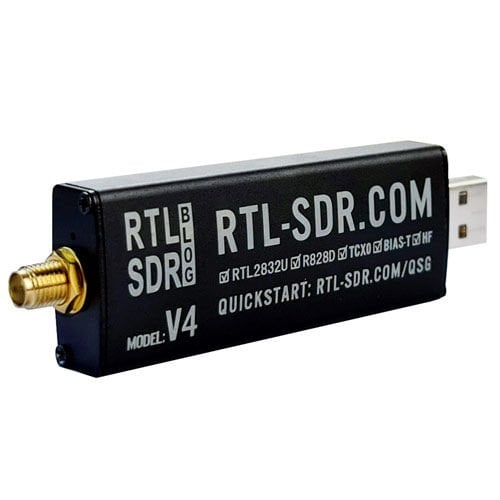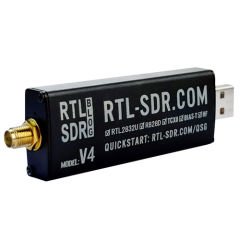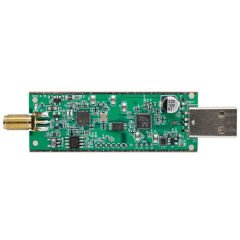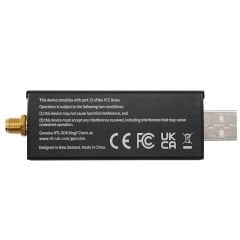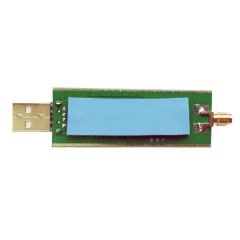RTL-SDR Blog V4 RTL2832U Software Defined Radio + Antennas
RTL-SDR Blog V4 R828D RTL2832U 1PPM TCXO SMA Software Defined Radio with Dipole Antenna Kit
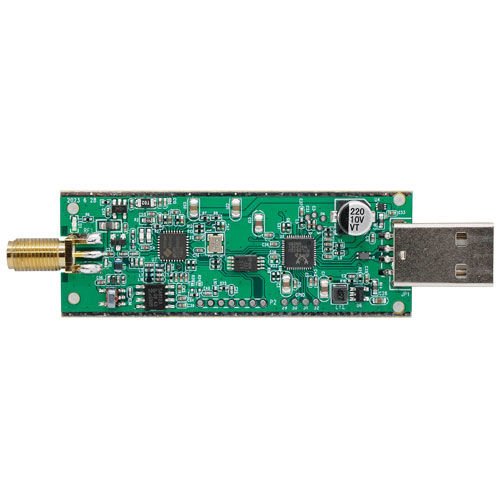

Includes 1x RTL-SDR Blog brand R828D RTL2832U 1PPM TCXO SMA V4 Dongle, 1x Dipole Antenna Base with 60cm RG174, 2x 23cm to 1m telescopic antenna, 2x 5cm to 13cm telescopic antenna, 1x 3 meter RG174 extension cable, 1x Flexible Tripod Mount, 1x Suction Cup Mount.
The best value RTL-SDR on the market! Several improvements over generic brands including use of the R828D tuner, triplexed input filter, notch filter, improved component tolerances, a 1 PPM temperature compensated oscillator (TCXO), SMA F connector, aluminium case with passive cooling, bias tee circuit, improved power supply, and a built in HF upconverter.
Comes with our portable dipole antenna kit. Great for beginners as it allows for terrestrial and satellite reception. Easy to mount outdoors and designed for portable and temporary outside usage. Please do not use outside during poor weather conditions.
Features
- <1 PPM temperature compensated oscillator (TCXO) – Accurate tuning and almost zero temperature drift (2 PPM max. initial offset, 0.5-1 PPM temperature drift)
- SMA female antenna port – Generic dongles use the less common MCX or PAL antenna ports. SMA is more common, so more adapters and antennas are available for it. It is also more durable and has lower RF insertion losses.
- 4.5V USB powered bias tee - This allows the RTL-SDR to power low noise amplifiers (like the LNA4ALL, HABAMP, RTL-SDR Blog ADS-B LNA) and active antennas through the coax cable. Can be enabled in software (see V3 / V4 users guide).
- HF Direct Sampling Mode (V3) or HF Upconversion (V4) - Listen to 500 kHz - 28.8 MHz with direct sampling on the V3 model, or upconversion of the V4 model. There is a built-in 25 MHz low pass filter, but additional HF filters may be required for optimal performance (e.g. to attenuate strong MW AM).
- Aluminium case and passive cooling - These units come stock with an aluminium case and passive cooling via a silicon thermal pad. This stops reception failing due to heat when used above ~1.5 GHz.
- (V4 Models) - Improved front-end filtering. The V4 model is less prone to being saturated by strong broadcast stations.
- Improved Antennas - We provide an excellent dipole antenna starter kit for newbies. Use the included mounts and extension cable to mount the dipole in good position for optimal reception. Receives terrestrial and VHF satellite signals.
- Various additional improvements compared to other RTL-SDRs – R820T2 tuner, higher quality passive components, a choke on the USB line to reduce USB noise, a much improved PCB design for significantly less internal spurs and noise, various break-out pads, improved ESD protection, additional bypass capacitors and ferrite power line chokes, improved front end matching circuit, a modified power design for improved long term reliability, modified PLL circuit for better stability at 1.5 GHz and above, and a better LDO.
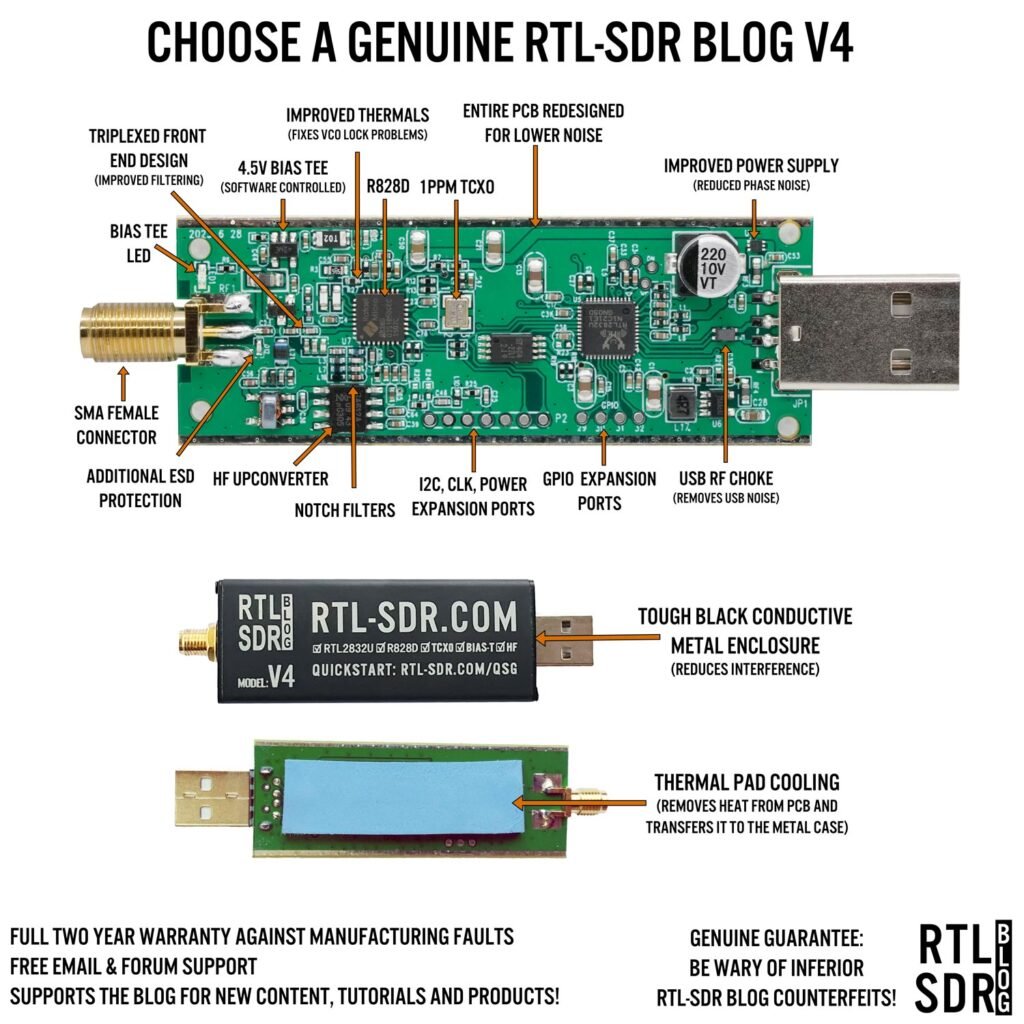
What is RTL-SDR?
RTL-SDR is a very cheap ~$30 USB dongle that can be used as a computer based radio scanner for receiving live radio signals in your area (no internet required). Depending on the particular model it could receive frequencies from 500 kHz up to 1.75 GHz. Most software for the RTL-SDR is also community developed, and provided free of charge. Note that RTL-SDRs cannot transmit.
The origins of RTL-SDR stem from mass produced DVB-T TV tuner dongles that were based on the RTL2832U chipset. With the combined efforts of Antti Palosaari, Eric Fry and Osmocom (in particular Steve Markgraf) it was found that the raw I/Q data on the RTL2832U chipset could be accessed directly, which allowed the DVB-T TV tuner to be converted into a wideband software defined radio via a custom software driver developed by Steve Markgraf. If you've ever enjoyed the RTL-SDR project please consider donating to Osmocom via Open Collective as they are the ones who developed the drivers and brought RTL-SDR to life.
Over the years since its discovery RTL-SDR has become extremely popular and has democratized access to the radio spectrum. Now anyone including hobbyists on a budget can access the radio spectrum. It's worth noting that this sort of SDR capability would have cost hundreds or even thousands of dollars just a few years ago. The RTL-SDR is also sometimes referred to as RTL2832U, DVB-T SDR, DVB-T dongle, RTL dongle, or the "cheap software defined radio".
There are now many other software defined radios better than the RTL-SDR, but they all come at a higher price. Currently we think that the Airspy ($169) and SDRPlay ($99) SDR's are the best low cost RX only SDR's. There is also the HackRF ($300USD) which can both transmit and receive.
What is Software Defined Radio?
Radio components such as modulators, demodulators and tuners are traditionally implemented in analogue hardware components. The advent of modern computing and analogue to digital converters allows most of these traditionally hardware based components to be implemented in software instead. Hence, the term software defined radio. This enables easy signal processing and thus cheap wide band scanner radios to be produced.
What are some RTL-SDR Radio Scanner Applications?
The RTL-SDR can be used as a wide band radio scanner. Applications include:
- Use as a police radio scanner.
- Listening to EMS/Ambulance/Fire communications.
- Listening to aircraft traffic control conversations.
- Tracking aircraft positions like a radar with ADSB decoding.
- Decoding aircraft ACARS short messages.
- Scanning trunking radio conversations.
- Decoding unencrypted digital voice transmissions such as P25/DMR/D-STAR.
- Tracking maritime boat positions like a radar with AIS decoding.
- Decoding POCSAG/FLEX pager traffic.
- Scanning for cordless phones and baby monitors.
- Tracking and receiving meteorological agency launched weather balloon data.
- Tracking your own self launched high altitude balloon for payload recovery.
- Receiving wireless temperature sensors and wireless power meter sensors.
- Listening to VHF amateur radio.
- Decoding ham radio APRS packets.
- Watching analogue broadcast TV.
- Sniffing GSM signals.
- Using rtl-sdr on your Android device as a portable radio scanner.
- Receiving GPS signals and decoding them.
- Using rtl-sdr as a spectrum analyzer.
- Receiving NOAA weather satellite images.
- Listening to satellites and the ISS.
- Radio astronomy and Galactic Hydrogen line measurements.
- Monitoring meteor scatter.
- Listening to FM radio, and decoding RDS information.
- Listening to DAB broadcast radio.
- Listening to and decoding HD-Radio (NRSC5).
- Use rtl-sdr as a panadapter for your traditional hardware radio.
- Decoding taxi mobile data terminal signals.
- Use RTL-SDR as a high quality entropy source for random number generation.
- Use RTL-SDR as a noise figure indicator.
- Reverse engineering unknown protocols.
- Triangulating the source of a signal.
- Searching for RF noise sources.
- Characterizing RF filters and measuring antenna SWR.
- Decoding Inmarsat STD-C EGC geosynchronous satellites.
- Listening to the ISS (International Space Station).
- Receiving images from Geostationary weather satellites.
Furthermore, with an upconverter or V3/V4 RTL-SDR dongle to receive HF signals the applications are expanded to:
- Listening to amateur radio hams on SSB with LSB/USB modulation.
- Decoding digital amateur radio ham communications such as CW/PSK/RTTY/SSTV.
- Receiving HF weatherfax.
- Receiving digital radio mondiale shortwave radio (DRM).
- Listening to international shortwave radio.
- Looking for RADAR signals like over the horizon (OTH) radar, and HAARP signals.
Note that not all the applications listed may be legal in your country. Please be responsible.
What is the RTL-SDR frequency range?
This is dependent on the particular tuner variant used in the dongle, and the particular implementation. Some dongles, like our RTL-SDR Blog V3 and V4 also have hardware enhancements that enable reception below 24 MHz.
| Tuner | Frequency range |
|---|---|
| Elonics E4000 | 52 – 2200 MHz with a gap from 1100 MHz to 1250 MHz (varies) |
| Rafael Micro R820T/2/R860 | 24 – 1766 MHz (Can be improved to ~13 - 1864 MHz with experimental drivers) |
| Rafael Micro R828D | RTL-SDR Blog V4 Model: 24 - 1766 MHz. Other models may have a cutoff around 1 GHz. |
| Fitipower FC0013 | 22 – 1100 MHz |
| Fitipower FC0012 | 22 – 948.6 MHz |
| FCI FC2580 | 146 – 308 MHz and 438 – 924 MHz (gap in between) |
As you can see from the table, the Elonics E4000 and Rafael Micro R820T/2/R860 and R828D dongles have the greatest frequency range.
What is the RTL-SDRs sample rate?
The maximum sample rate is 3.2 MS/s (mega samples per second). However, the RTL-SDR is unstable at this rate and may drop samples. The maximum sample rate that does not drop samples is 2.56 MS/s, however some people have had luck with 2.8MS/s and 3.2 MS/s working well on some USB 3.0 ports.
Dropped samples are okay if you are just visualizing the spectrum, but will cause problems if you want to demodulate/decode signals.
What is the RTL-SDR's ADC resolution?
The native resolution is 8 bits, but the Effective Number of Bits (ENOB) is estimated at ~7. Decimation in software may raise this value.
What is the RTL-SDR input impedance?
Since these dongles are intended for TV, most dongles will have an input impedance of approximately 75 Ohms, although it is unlikely to be exactly 75 Ohms over the entire frequency range.
Remember that the mismatch loss when using 50 Ohm cabling on a 75 Ohm input will be very minimal at less than 0.177 dB.
The 75 Ohm impedance for the R820T can be checked on the datasheet which can be downloaded here.
However, newer dongles that come with SMA connectors will be 50 Ohms.
What are the minimum PC requirements?
Generally, at least a dual core processor of some sort will be required for most general GUI based software defined radio software. Command line tools and ADS-B decoders may work with less powerful hardware. Single board PCs like the Raspberry Pi 3, and Android mobile devices can also run several applications.

